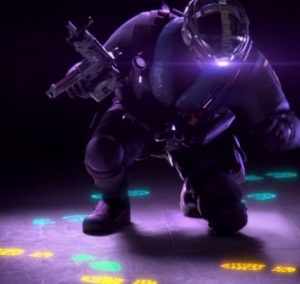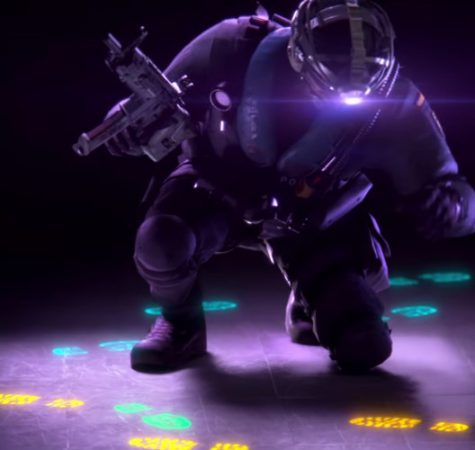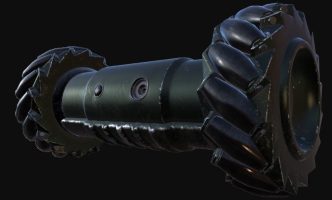Introduction
Why hunt roamers
ATTACKING GUIDE
ROAM CLEAR
When to hunt roamers

- Number of anchors is less than roamers
If the defensive squad has 3+ roamers, then I suggest pushing objective directly and decisively.
Do not waste time playing their game. Force roamers to come to you on your terms.
Pushing 1-2 anchors on the objective should not cause as much trouble as search & destroy attempts all over the map.
If your team is unable to kill outnumbered anchors, then probably you would not win this round anyway.Roamers love playing against teams that neglect them. In such a case, the roamer will wait for the right moment to strike the attacking team during objective push while having freedom of movement around the map.
If your team decides to push objective directly and ignore roamer(s), ensure you have a flank watch. This is especially true in case the attack comes from one direction. You do not need all 4-5 guns pointing the same angles.
- Number of anchors is higher than roamers
If defenders have 1-2 roamers, then you might want to consider hunting roamers first.
Directly pushing the objective will probably result in a prolonged fight due to the higher number of anchors present on site.As a consequence:
– roamers will have time to flank you
– you won’t be able to dedicate full manpower to either task – pushing anchors or watching for flank
– you let defenders pinch you, rather than pinching them
Determining the number of roamers

- operators identification
- preparation phase dronesBesides identifying operators, preparation drones located in common spots for leaving objective can also help to identify potential roam locations and the number of roamers.
- droning objective mid-roundUsing your drones to check objective is another excellent way to verify roam situation. If you see four defenders on site, then you know for sure that only one defender is potentially roaming. Seeing one defender on site is an excellent indication to push aggressively.Bear in mind that you might have missed some defenders or that they are near the objective.
Hunting roamers efficiently
Methodology
- Locate roamer(s) position
This point is the first and most important aspect of hunting roamers effectively.
Locating roamers can be achieved by tracking them with Jackal or droning the map to identify roamers’ position.Just remember that roamers are usually very mobile players, so do not count blindly on the intel you received 20-30 seconds ago about location. The older the intel is, the less reliable it becomes!
- Drone and communicate
First of all, save your preparation phase drone. It will give you additional flexibility and confidence.
We have discussed droning thoroughly in our droning guide, so make sure to check it out!
The best way to drone and communicate is by having a teammate droning for entry fragger.Try to distract roamers with drones.
Spotting is excellent when you do so with a teammate following the mark by either pushing or wall-banging the roamer.With time communication and understanding between teammates will improve. If you are playing with randoms, tell them that you are going to spot a couple of seconds before and where.
On the other hand, let your “drone buddy” know about the upcoming push from your side (if you’re the entry fragger)
- Pinch defender
Roamers want to move around the map to disorient attackers constantly.What the attacking team should try to achieve is to limit roamers’ options for the rotation, by watching possible escape routes and methodically closing the circle on a trapped roamer.
- Push with teammate
Hunting roamers alone is a recipe for being killed without any benefit to your team.
On the contrary, pushing roamers with your teammate supporting allows trading kills – your teammate is likely to get a kill even if you die. It is always better to get a 1:1 ratio than let roamer get away with a kill, And waste more attackers’ time while giving man count advantage to his team.
Roamer is unlikely to kill two attackers pushing him at the same time. However, bear in mind to avoid pushing from the same angle. Such positioning nullifies manpower advantage. - Act decisively
This point is not a mechanic, but rather the mindset needed to efficiently deal with roamers.
Too often we see people getting information on opponents’ positions and waiting for the roamer to make a move. Such a tactic may work at times, but you create dependency on your opponent’s actions, rather than the habit of relying on your team’s intel and your own skills.Instead, we propose to take the necessary steps and act on the received intel without hesitation. In the beginning, you may act a bit reckless, but with practice, you will learn the balance between the two.
Remember: defenders are happy to waste your time, while you are constrained by the clock!
Roam hunt tools
Operator choices
Select operators who improve your odds when clearing roamers, such as:
- Jackal
THE roamer hunter. Jackal allows pin-pointing roamer’s location for a major portion of the round (as long as tracks are available). Thus his role is location-oriented.If your team tends to have problems with hunting roamers, then I recommend to try dedicating a person to this role and see whether the improvement will be noticeable.
Just remember that marks are not live, scan happens every 5th second.

- Dokkaebi
Her logic bomb provides sound cues about the roamer’s presence and disrupts them for the duration of “phone call.” Similarly to Jackal, Dokkaebi’s role in hunting roamers is to identify their location effectively, with the addition of disruption (sound disruption, turning off the phone animation).Please remember that not every defender will choose to turn off the logic bomb immediately. More experienced players will decide to bait attackers, who may be careless expecting to catch defenders off guard.
- Lion
His EE-ONE-D forces the roamer to make a decision: either stand still or reveal his/her position.
Therefore, Lion’s utility is both location-oriented and disruption-focused.Our recommendation is to use EE-ONE-D for forcing defenders to stand still when your team decides to push them, after obtaining intel about roamer’s presence.
Choosing when you use Lion’s utility is especially important now, with the shorter duration of the skill. - Blitz/Montagne
Both shield operators are great at pushing roamer away from their spot and forcing them to either:- focus on shield operator and as a result, be vulnerable to other attackers
- ignore shield operator, thus being exposed to Blitz/Montagne players melee or pistol shots
Fraggers like Zofia can use disruption (concussion grenades) to give attackers an advantage while having excellent guns.
Ash, on the other hand, is fast and has a great gun to deal with pesky roamer.
Gadgets selection
- Stun grenades
Stun grenades can blind pushed defenders, giving an advantage to attackers in a gunfight. The most significant counter to Stuns is ADS, which is unlikely to be at the roamers location (usually placed on the objective).
Unfortunately, stun grenades tend to be inconsistent in Rainbow Six Siege. We recommend using 2 or even 3 stuns in succession to increase the odds of the defender being actually blinded. - Frag grenades
Frag grenades will help you to either flush out defenders or get an easy kill.
Remember that you can “cook” a grenade in your hand (holding the grenade button) to give the defender less time for running away from it.
Roam hunt scenarios
- defenders have 1-2 roamersIf defenders have more roamers than anchors, pushing objective fast may be the best option.
Otherwise, when working together as a team, you should be able to locate and isolate 1-2 roamers.
- The objective is on either the ground floor or in the basementWith objectives placed in such locations, roamers usually have multiple ways from which they can hit attackers.
Countering flank
Definition

Methodology
- Use sound and actions that attract roamers to your advantage
Many roamers will attempt a flank when:
- Hearing loud noises that indicate attackers are pushing or are distracted, such as explosions, breaching, or firefights.Example: Attackers opened a hatch in the kitchen on Club House, with the objective in Armory (basement).Explosion sound will attract roamers to initiate the flank of the kitchen.
- Receiving a callout from a teammate about the situation that indicates a good time for flankExample: attackers opened fireplace hatch on Chalet, with objective below.
You can expect the opposing team to communicate such info, which will prompt a roamer to flank.
How can you use such behavior to your advantage?
Flank’s most significant advantage is an element of surprise. By expecting a roamer to flank your team, you eliminate surprise, therefore, giving yourself an edge. If you or your team made a loud sound, put yourself in an advantageous position, and aim at a spot you expect roamer to pop out from.However, remember that flank is not guaranteed. Try to avoid wasting half of the round waiting for a potential flank unless you are asked by your team to focus on doing so!
- Dedicate a flank watcher
A dedicated flank-watching person has the main role in ensuring that roamers won’t be able to flank your team.
Having such a role fulfilled gives confidence to the rest of the attacking team to entirely focus on their tasks and pushing the objective site decisively.A flank watch is an especially useful and recommended tool when your attack on an objective comes from a single direction.
There is no need for all attackers to watch the same angles and push at the same time (unless you are rushing). Instead, have one teammate cover your back. Skilled defensive teams will realize singular push direction quickly and reveal such information to their roamers.
Flank watch tools
Operator choices
Select operators who improve your odds when successfully watching flank and capitalizing on it, such as:

- Nomad is a fantastic operator to help to prevent surprising flanks.
Unlike claymores, when placed well, Airjabs are virtually impossible to spot. They do, however, make a distinctive sound when in close proximity.
Airjabs:• Provide heads-up notification about upcoming flank. In most cases will demotivate the defender from carrying on the flank• Neutralize the flanker for a couple of seconds. Attackers present nearby can utilize such to kill impacted defender without risk
- A Year 4 DLC addition to the Rainbow Six Siege roster is another flank prevention specialist.Stingers cover vast areas when fully deployed and force defenders to neutralize Gridlock’s utility before crossing terrain.Such action will result in delay and creating warning sounds for attackers to expect flank.
Gadgets selection
- Claymore
Before Y3S3 Claymores were the only utility available to attackers that could help them with preventing flanks.
Claymores can be placed on any flat surface, but by now experienced players have learned usual placements spots and to watch for red laser when performing flank.This doesn’t mean you shouldn’t use Claymores. They are still useful and can help catch careless flankers. However, they are less reliable in their role than either of the operators mentioned above.
Flank watch scenarios
- Defenders have 3+roamersWhen defenders decide to roam and leave objective unattended, we recommend to ignore them. Choose the direction of approach that is left vulnerable and attack decisively.
- The objective is placed on the top floor
OR - Only one route can lead to flankSuch objective locations are usually relatively easy to prevent a flank due to a limited number of angles to be watched and be hit from. The main difficulty will be to clear the area surrounding the flank-able route.



